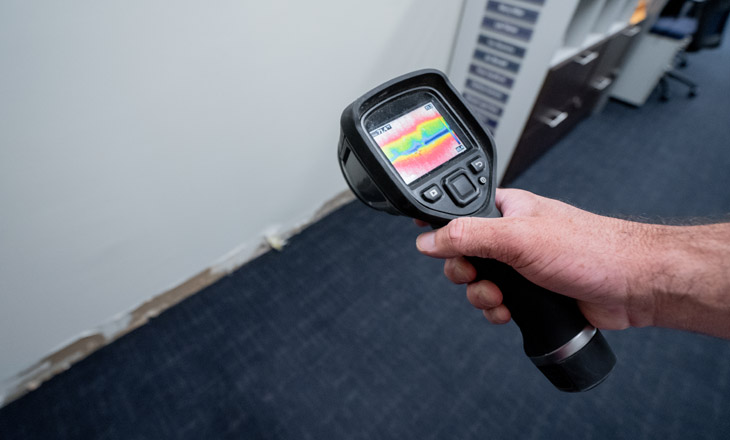Prevent Major Issues with Early Water Leak Detection and Prompt Repairs
Prevent Major Issues with Early Water Leak Detection and Prompt Repairs
Blog Article
Cutting-edge Solutions for Early Detection of Water Leakages in Buildings and Facilities
From innovative leakage discovery innovations to the deployment of IoT sensing units for real-time tracking, the landscape of leak avoidance is evolving rapidly. Automated water circulation evaluation systems are reshaping how leakages are recognized and dealt with, leading the means for a positive strategy to water leak detection.
Advanced Leakage Discovery Technologies
Advanced leakage discovery modern technologies, furnished with innovative sensing units and algorithms, play a critical duty in promptly recognizing and pinpointing water leakages in various settings. These technologies utilize a mix of acoustic, thermal, and electro-magnetic picking up methods to find leakages properly. Acoustic sensing units spot the noise of leaving water, enabling specific localization of the leak source. Thermal imaging finds temperature level adjustments brought on by water leakage, providing an additional effective technique for leak identification. Electromagnetic sensing units can identify modifications in magnetic fields brought on by water, using yet one more layer of leakage discovery ability.

IoT Sensors for Real-Time Surveillance
In the realm of modern water leak discovery, the assimilation of IoT sensing units for real-time tracking represents a pivotal development in boosting aggressive leak detection abilities. These sensors use continual surveillance of water systems, providing real-time data on water flow rates, pressure variations, and temperature modifications. By leveraging IoT modern technology, these sensing units can detect even the smallest anomalies in water usage patterns, enabling early identification of possible leaks before they intensify into major issues.
IoT sensors transmit data to a centralized system, where innovative formulas examine the info and produce notifies or notices when irregularities are spotted. This real-time monitoring capability permits home owners or facility supervisors to immediately attend to leaks, minimizing water damages, minimizing repair service expenses, and conserving water resources.
In addition, IoT sensing units can be integrated with structure monitoring systems, enabling for automated feedbacks to identified leaks, such as shutting off water shutoffs or triggering pumps to mitigate the influence of leakages. Generally, the implementation of IoT sensing units for real-time tracking significantly boosts the effectiveness and effectiveness of water leakage detection in structures and facilities.
Artificial Intelligence Algorithms for Leak Prediction

One key benefit of utilizing artificial intelligence for leakage prediction is its capacity to constantly learn and boost its accuracy over time. As visit this page even more data is accumulated and fed into the algorithm, it can fine-tune its predictions and adjust to altering problems, eventually increasing the integrity of leak discovery systems.
Additionally, device learning formulas can help in recognizing subtle indicators of leakages that may go undetected by conventional surveillance techniques. water leak detection. By evaluating complex information sets in real-time, these formulas can provide very early warnings and signals, permitting prompt intervention and preventative maintenance to alleviate potential water damage and linked costs
Using Thermal Imaging for Leakage Detection
Thermal imaging modern technology supplies a promising approach for discovering water leaks in numerous systems and infrastructures. By using infrared radiation and temperature level differences, thermal imaging cameras can determine surprise leakages that are not quickly noticeable to the nude eye.
One of the crucial advantages of thermal imaging for leakage discovery is its useful reference non-intrusive nature. In general, the usage of thermal imaging modern technology improves the efficiency and precision of water leak discovery, making it a beneficial tool for maintaining the honesty of buildings and frameworks.
Automated Water Flow Evaluation Solutions
How can computerized water flow evaluation systems reinvent the detection and monitoring of leaks in numerous systems and infrastructures? Automated water circulation analysis systems use a proactive technique to leak discovery by constantly keeping an eye on water flow prices and patterns. By establishing standard information, these systems can swiftly determine deviations that might indicate a leakage, enabling punctual intervention to stop extensive damages.
These systems utilize sophisticated algorithms to examine real-time data and supply immediate notifies when abnormalities are discovered, permitting for quick action to be taken. Furthermore, automatic water flow evaluation systems can be integrated with structure monitoring systems or IoT platforms, enhancing overall efficiency and making it possible for remote tracking capacities.
Moreover, the information accumulated by these systems can be utilized for predictive upkeep functions, aiding to identify potential powerlessness in the facilities prior to leakages happen. Generally, the application of computerized water flow evaluation systems can significantly enhance leakage discovery and monitoring techniques, inevitably resulting in set you back savings, lowered water wastefulness, and boosted sustainability in buildings and infrastructure.

Conclusion
In final thought, the combination of innovative leakage discovery modern technologies, IoT sensors, machine knowing algorithms, thermal imaging, and automated water flow analysis systems provides innovative services for early detection of water leaks in structures and framework. These modern technologies make it possible for real-time surveillance, forecast of leakages, and effective detection techniques to avoid water damage and wastage. Implementing these solutions can aid in preserving the stability and sustainability of water systems in various setups.
Report this page